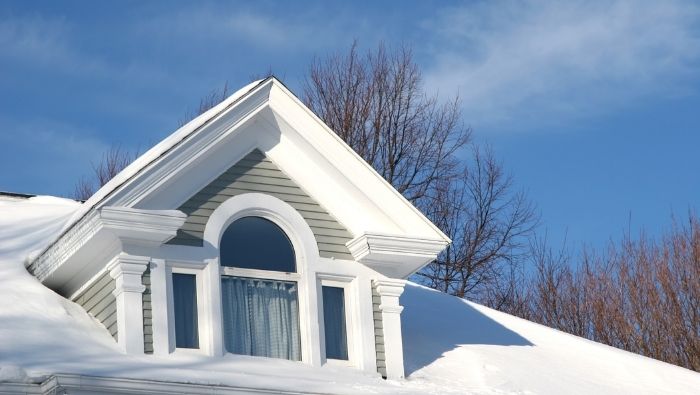Inspecting Your Roof for Winter Damage

Taking these steps to inspect your roof for winter damage each spring can help lengthen the life of your roof and minimize costly repairs.
A roof helps regulate the temperature inside the home throughout the year and safeguards the residents from all kinds of climatic conditions. Spring is a marvelous time to evaluate the damage to your roof because by then the snow would have melted and you get a clear look at the shingles.
The roof is the most vulnerable to damage from a severe winter, and a thorough inspection is necessary to pinpoint any problems that might have arisen. These guidelines for inspecting your roof for winter damage can help.
No Rush
Wait for spring weather to dry out your roof. Walking on a wet roof is foolhardy, and there is a chance that your roof will have black ice that’s not easily visible.
What Can Happen to Your Roof?
The weight of the snow can cause structural damage to the roof, especially if there is a lot of snow on it for a long period of time.
Ice damming is another thing to watch out for. Due to the frequent extremes in temperature during winter, the snow can melt into the eaves and gutter before turning into ice again. This ice then keeps accumulating and can block the water from flowing out through the gutters. As a result, the water has no outlet and can start dripping inside your home.
Gutters can also become loose due to the weight of the frozen ice.
Sign Up for Savings
Subscribe to get money-saving content by email that can help you stretch your dollars further.
Twice each week, you'll receive articles and tips that can help you free up and keep more of your hard-earned money, even on the tightest of budgets.
We respect your privacy. Unsubscribe at any time.
What To Look For
Water stains inside your home are a sure sign that snow has damaged your roof. Also, look for damp or cracked plaster. Now is a good time to check the chimney and the ventilation pipes for any signs of damage or leakage. Check the underside of the roof from the attic.
Then, check the roof from the outside. Cracked, missing, warped, broken, or loose shingles should be repaired. Sudden changes in the temperature may have caused buckled or slightly raised shingles.
While you are up on the roof, check the eaves and gutters thoroughly to see if all the vent caps are in place and if the flashings are tightly fitted. If you have used cement or sealant in the past to repair any part of the roof, now is a good time to see if it is still in place. Inspect all the joints and turns carefully to make sure that all are in place and there are no cracks or gaps anywhere.
Setting it Right
Minor problems can usually be easily fixed with simple tools like nails, a hammer, a caulking gun, a palette knife, and some sealant or cement. Of course, a ladder and appropriate safety equipment will likely be required. Let someone know that you’re on the roof and have them check on you frequently.
If there is any moss or lichen on the roof, it will have to be removed to allow you better access. You can either sweep it off or use a chemical to kill it first.
If there are any cracks along the flashing, these will have to be filled in. Also, look for any missing or broken nails. Make sure you use roofing nails for replacements.
If a whole width of a shingle has to be replaced, the old one will have to be removed carefully first. Any nails remaining nails will have to be pulled out before the new shingle can be put in.
Precautions
Proper precautions can avoid some winter roofing problems. As you inspect your roof, look for ways to prevent similar problems next year.
Taking time now to check your roof for problems will not only lengthen the life of your roof, but it could prevent expensive repairs later.
Reviewed March 2024
About the Author
Benjamin Roussey is from Sacramento, CA, and grew up doing all varieties of home improvement projects around the home since his parents did not hire contractors or outside help to maintain their home or vehicles. As a result, he has acquired a multitude of home handyman skills in plumbing, carpentry, electrical and everything in between.
Popular Articles
- 7 Habits of Highly Frugal People
- 5 Simple Budget Cuts That Can Save $200 a Month
- How to Track Down Unclaimed Funds Owed You
- 32 Ways to Save Money on Your Utility Bills
- Do You Need Credit Life Insurance When Buying a New Car?
- How to Maximize Profits When Selling Online
- Staying Motivated to Continue Digging Yourself Out of Debt
On After50Finances.com
- 9 Things You Need to Do Before You Retire
- You Didn’t Save Enough for Retirement and You’re 55+
- When Empty Nesters Reorganize and Declutter Their Home
- Reinventing Your Career in Your 50s or 60s
- What Mature Homeowners Should Know about Reverse Mortgages
- 2 Reasons to Collect Social Security Benefits As Soon As Possible

